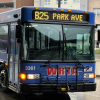Bruce Marks has already been a “disruptive force” for mortgages. Now, he’s targeting the construction of new housing with what he calls the “one-dollar program.”
“We want to be — and are becoming — the disruptive force on the homeownership on the new construction side,” said Marks, CEO of the Neighborhood Assistance Corporation of America , a nonprofit homeownership organization that has helped tens of thousands of people secure mortgages.
Marks has made headlines for more than a decade for NACA’s innovative approach to lending. He’s building on the longstanding initiative to get mortgages in the hands of people often excluded by banks with the budding new construction program — plus, a mapping project to educate and empower residents across the commonwealth to learn: who owns Massachusetts?
He attributed his success in mortgages to “respect for the homebuyers” in a Boston Public Radio appearance Monday. NACA uses different criteria than traditional banks to evaluate whether people will meet their mortgage payments, doesn’t ask for down payments or closing costs, and offers a fixed-rate mortgage.
“The secret sauce is the underwriting where you don’t look so much at the credit score. You look at the payments that they control,” Marks said. “And we get the job done.”
More Local News
NACA has helped provide over 75,000 mortgages and has a low foreclosure rate — about a hundreth of a percent. And the vast majority of NACA’s homebuyers are people of color.
“We have respect for the homebuyers,” Marks said, explaining the organization’s success. “So we put them through the counseling. So we do the financial management counseling, so it’s comprehensive.”
The concept of no–down payment mortgages in the United States goes back nearly a century, Marks said, to mortgages guaranteed by the Department of Veterans Affairs. The program was established in 1944 to provide assistance to veterans returning from overseas.
“What built the white middle class after World War II? It was the no–down payment, VA mortgage,” he said. “So the concept is not new, but we put people through that counseling where they can know where they’re spending their money and they can adjust their spending.”
With its new “one-dollar program,” the organization hopes that people can buy vacant lots or foreclosed properties from their city or town for a low price. Then, they can put a low-cost but durable pre-fabricated home on the property.
He says that it was inspired by the clear dearth of available housing. Marks recalled that, a few months ago, NACA went into rural communities in Alabama to educate residents on their homebuyer programs, communities that he says are “really overlooked by the government.”
“That’s where the new construction came from. Because you look at these communities — they need the new construction, they need the rehab,” he said.
So far, NACA has built one home as a model but expects to soon build 500 to 1,000 each year.
Marks is also working on a new mapping project, devoted to answering the question: Who owns Massachusetts? With funding from the Lynch Family Foundation, he’s looking at land records of the more than 2.5 million properties in Massachusetts to see who’s buying up the commonwealth’s homes.
“Who are the outside investors? Who are the multi-investors out there who are really going after these properties and buying properties, particularly in the minority communities, and renting them out with no intention, really, of selling them to homebuyers? So they are destroying and stealing the dream of affordable homeownership. And then you can see the public housing out there that is really essential.”
So far, Marks said that he has shared the map with officials including Massachusetts Auditor Diana DiZoglio and Lieutenant Gov. Kim Driscoll.
“This is a tool — not just for them, but for the community residents out there,” he said. The color-coded map will plainly show viewers who owns every single property in the state. “To give them the tools to see: who owns the properties in their neighborhood?”









